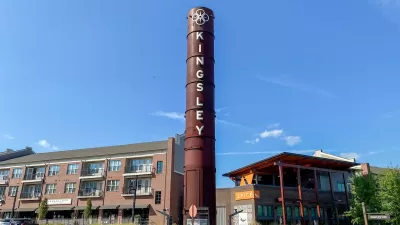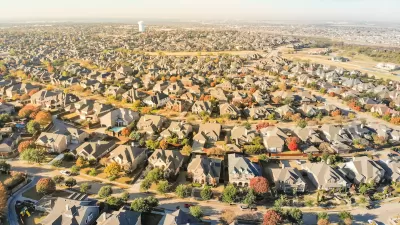With more people moving away from central cities, we have the chance to avoid past mistakes and redesign the American suburb to be less car-centric and more diverse.

What if we reinvent the suburbs to be more sustainable? That’s what Addison Del Mastro asks in a recent piece on Vox. Del Mastro argues that, with remote work changing the nature of commuting and more millennials looking to buy homes, now is the time to reenvision what suburban life could look like and write a “second draft” that’s better than the first.
“The demand for something like urban living is real. Even at the outer edges of growing metro areas, mixed-use walkable developments pop up alongside familiar subdivisions and McMansions.” Indeed, “Between 2019 and 2020, the share of millennials who live in suburbs increased by 4 percentage points; and in 2014, more than 60 percent of immigrants lived in suburbs, up from just over half in 2000.”
As Del Mastro has written before, immigrant communities are transforming the strip mall and other suburban spaces to accommodate different uses and culturally relevant services. “The ongoing diversification of the suburbs is coinciding with the appearance of New Urbanist, mixed-use development there, and the renewed interest in suburban living following the pandemic. The makings of a suburban transformation are here.”
As Del Mastro points out, “Zoning codes were not really meant to be perpetual; master plans were supposed to guide their evolution over the decades, planning for and accommodating growth.” It’s time for the suburbs to embrace change, and for planners to recognize their potential to transform into more walkable, sustainable, and diverse communities.
FULL STORY: What if the suburbs were just a first draft?

Alabama: Trump Terminates Settlements for Black Communities Harmed By Raw Sewage
Trump deemed the landmark civil rights agreement “illegal DEI and environmental justice policy.”

Study: Maui’s Plan to Convert Vacation Rentals to Long-Term Housing Could Cause Nearly $1 Billion Economic Loss
The plan would reduce visitor accommodation by 25% resulting in 1,900 jobs lost.

Planetizen Federal Action Tracker
A weekly monitor of how Trump’s orders and actions are impacting planners and planning in America.

Wind Energy on the Rise Despite Federal Policy Reversal
The Trump administration is revoking federal support for renewable energy, but demand for new projects continues unabated.

Passengers Flock to Caltrain After Electrification
The new electric trains are running faster and more reliably, leading to strong ridership growth on the Bay Area rail system.

Texas Churches Rally Behind ‘Yes in God’s Back Yard’ Legislation
Religious leaders want the state to reduce zoning regulations to streamline leasing church-owned land to housing developers.
Urban Design for Planners 1: Software Tools
This six-course series explores essential urban design concepts using open source software and equips planners with the tools they need to participate fully in the urban design process.
Planning for Universal Design
Learn the tools for implementing Universal Design in planning regulations.
Caltrans
Smith Gee Studio
Institute for Housing and Urban Development Studies (IHS)
City of Grandview
Harvard GSD Executive Education
Toledo-Lucas County Plan Commissions
Salt Lake City
NYU Wagner Graduate School of Public Service





























